People in the Project Economy have all the skills and capabilities required to turn ideas into reality, regardless of the type of project they are working on. It is the process by which organizations provide value to stakeholders by completing projects, delivering products, and aligning with value streams.
Project-based work has well-defined goals, milestones, deliverables, and a start and end date. Projects can last hours, months, or years, depending on the project and business needs. However, the work is focused on business needs and objectives rather than specific roles.
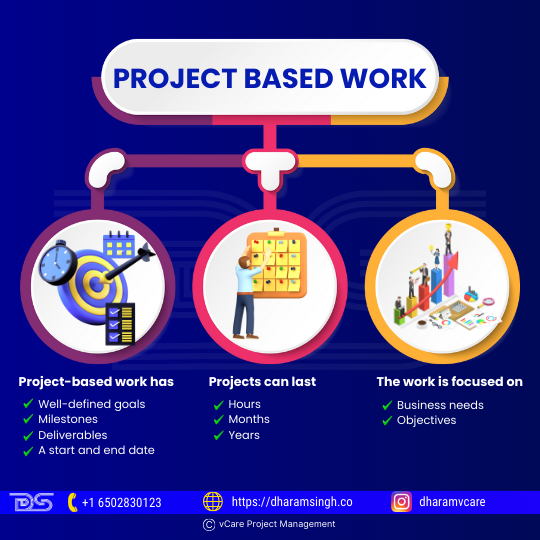
Project Based Work
Business leaders always want their teams to be agile and nimble. Adopting a project-based work mindset can help them achieve their goals. In addition, according to a recent MIT and Deloitte report, executives are increasingly viewing their workforce as an ecosystem, drawing on the diverse skill sets of their full-time employees and freelancers to meet business challenges.
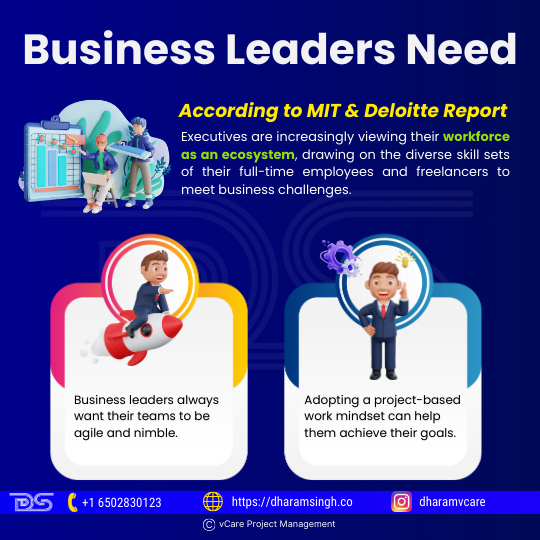
Business Leaders Need
The Project Economy Has Arrived
The Harvard Business Review Project Management Handbook (2021) by Antonio Nieto-Rodriguez states that:
- By 2027, nearly 88 million people worldwide are expected to be employed in project management, and the value of project-oriented economic activity is expected to reach $20 trillion.
- However, research shows that only 35% of global projects are successful, implying that project professionals waste time, money, and opportunity.
- To capitalize on the new project economy, businesses must adopt a project-driven organizational structure to ensure executives can sponsor projects and train managers in modern project management.
The Rise of the Project Economy
Berkley’s guide states that the rise of the Project Economy will play an essential role in the Future of Work. The following statistics from the below-mentioned survey make this statement more accurate:
- Almost 80% of executives believe the future of work will be project-based rather than role-based.
- More than 85% of all highly skilled independent contractors work in the Project Economy.
- According to the PMI, project-based economic activity will increase by 68 percent, from $12 trillion in 2013 to $20.2 trillion in 2027. Employers will require 87.7 million PM-related specialists by 2027.
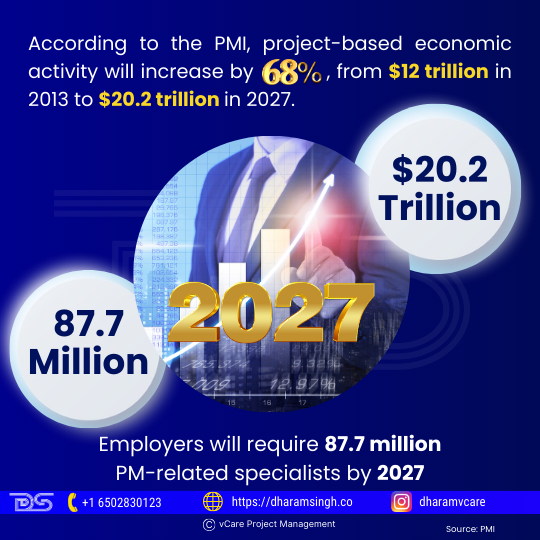
PMI Report
- 89% have at least one project management office (PMO), and 50% have multiple.
- Project work is expected to increase by 68% in the future, according to The State of Project Management report by Wellingtone.

Rise of the Project Economy
Challenges for the whole organization
The world is changing faster than ever, and businesses need help keeping up. However, savvy companies understand that the solution lies in developing and leveraging their people’s most valuable asset.
According to Global Talent Trends 2022 studies, workers are more stressed than ever. Eighty-one percent report being at risk of burnout, and one in five blame working for a company whose values do not align with theirs.
Human resource and project managers face many challenges in the whole organization.
- Close Skill Gap
Planning and managing long-term skill development will become more important as people lead longer, more diverse careers. Digital skills are now expected, and knowledge of business processes and related concepts is considered a core competency in every worker’s skill set.
Analytical and critical thinking skills have progressed from the exception to the norm, while interpersonal and leadership abilities are more valued than ever. Yet, many businesses face crucial skill shortages, particularly in retail, construction, real estate, manufacturing, education, medical and health services. According to McKinsey, 87 percent of executives report or expect skills gap challenges in the next few years.
- Initiatives to improve hiring
Hiring talented, qualified people has become critical to business success in a world of labor shortages and job-hopping. But it takes work.
- According to Josh Bersin’s study, 74 percent of businesses in the United States underperform when hiring, and only 60 percent of newly created jobs are filled.
- Businesses are attempting to attract not only talented but also diverse employees: The State of DEI Efforts report states that Finding various candidates with appropriate qualifications is the most difficult challenge for 43 percent of respondents.
- Also, Glassdoor’s Diversity and Inclusion Workplace Survey states that 76 percent of job seekers and employees value a diverse workforce when evaluating companies and job offers.
- Leadership development
Living in a volatile, uncertain, complex, and ambiguous (VUCA) world has become the norm. Influential leaders must be agile, constantly reevaluate and iterate their leadership practices, and strongly desire to build resilience for the future.
Organizations must adapt to new levels of complexity and ambiguity due to the COVID-19 pandemic’s disruption of the global economy and traditional modes of operation. The recovery from COVID-19 and the long-term impact of its disruption remain unknown. However, many organizations plan to meet their strategic goals and objectives as things begin normalizing. They must be especially cautious in the VUCA world.
VUCA: Companies and managers must embrace versatility, agility, and discomfort to progress. Covid-19 was the year of the phygital revolution – the physical, digital, and online-offline workplace convergence. In such a VUCA environment, managers and companies must be versatile, uncomfortable, collaborative, and agile to progress in a Phygital world. Therefore, every company and leader must be skilled in being versatile, uncomfortable, collaborative, and agile.
- Workforce retention
The ‘Great Resignation’ has resulted in historic numbers of people quitting their jobs, with the following industries suffering the most:
- Leisure and hospitality
- Trade, transportation, and utilities
- Professional and business services
- Education and health services
- Manufacturing
- Construction
Businesses are grappling with the issue of how to retain employees. One solution is to provide employees with opportunities for learning and skill-based career growth. However, employees see professional development opportunities as the most important way to improve and change the company culture.
- The Workplace Learning 2022 Report states that 46% of L&D leaders said upskilling or reskilling was a top focus area this year; internal mobility, career pathing, and employee retention fell toward the bottom.
- According to The American Upskilling Study 2021 study, 66 percent of workers aged 18-24 ranked upskilling opportunities as the third-most important benefit in evaluating a new job, and 48 percent of workers in the United States would relocate for such opportunities.
- Enterprise agility
To thrive in a highly dynamic world, organizations must quickly adapt to changing technology, markets, and customer needs. Enterprise agility denotes a shift away from traditional hierarchical structures and disconnected teams toward an operating model that optimizes strategy, structures, processes, people, and technology.
Rather than being hindered by the relentless pace of change, agile enterprises are more likely to capitalize on emerging technologies and business trends to differentiate themselves from the competition. However, as per a McKinsey report, two-thirds of businesses say they need to prepare for workforce disruptions brought on by technological and market trends.
- The transformational potential of learning
Employees and organizations are moving together as they navigate the complexities of a rapidly changing world. Workers must embrace a culture of lifelong learning to remain relevant. The benefits for businesses are evident, with skilled workers becoming more agile and motivated. In addition, Upskilling and reskilling can transform society as a whole, allowing under-represented groups to participate in the economy and be more involved.
- Impact of Emerging Technologies
Emerging technologies continue to influence how we live, work, and interact in a world driven by digital solutions. Many technological advancements are beneficial: they increase productivity, make necessary services more accessible, and generally make our lives easier.
Emerging technologies such as artificial intelligence (AI), robotics, the Internet of Things (IoT), blockchain, cybersecurity, and big data can make products and services more widely available, particularly to those currently unable to use them.
Several significant benefits for business processes should also be considered. Businesses already use a variety of digital solutions to attract customers, such as applications and websites. By 2030, approximately 70% of companies worldwide will have adopted at least one type of AI technology, with other emerging technologies being implemented quickly. Thus, technological solutions will continue to automate and innovate our work.
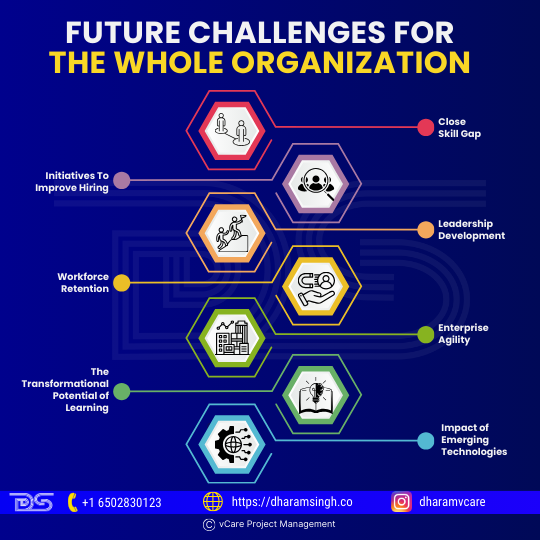
Future Challenges for the Whole Organization
Perspective Competency and Strategic Envisioning
A better approach would be to stop thinking about today’s challenges in terms of ‘project management.’ Instead, we must reframe the question to how we can do our work most efficiently. This also entails abandoning the notion of project management as a technical discipline in favor of viewing it as a collection of skills and disciplines required to complete work today. Christoffer Ellehuus, in the article Succeeding in the Project Economy, outlines four significant components for this phase.
- Strategy
Executing a strategy must be rooted deeply in the organization and must be understood by all. The biggest challenge is selecting the right work and eliminating unnecessary tasks. In addition, identifying opportunities for innovation, growth, and value creation are critical areas for improvement.
- Work
Work completion necessitates action in three areas: process expertise, workflow management, and innovation. The most challenging priority is managing multiple priorities and interrelated work streams. Project management is a skill that should be developed in every sector.
- People
80% of managers see the need to create conditions for leading in an environment of ambiguity. 79% know the challenge of leading through change or transformation as a priority. A significant shift in how leaders approach people management is required to nurture team members and build the capacity to deal with challenges.
- Self
A well-developed ability to manage and improve your capacity is immensely valuable. Therefore, the most urgent focus areas are to build creative, problem-solving, and critical-thinking skills.
Understanding Generation Z in the workplace
A new generation brings a new outlook on work. Generation Z is already an undeniable force in shifting corporate culture. By 2025, Gen Z employees will account for 27% of the workforce, bringing their expectations and values. There may be an area where an existing employee’s opinions, ideas, and working patterns vary. So, there should be an area to bridge the gap between the experienced and Gen Z employees.
Bridging the Gap – Experienced vs. Generation Z
Today, younger generations are entering the workforce. At the same time, older employees remain in the workforce for longer due to economic necessity. In the workplace, the experienced and Generation Z employees may have noticed a few challenges and questions to the management while allocating them a task together:
- Do these coworkers have difficulty conversing with one another?
- Do they appear to have opposing processes and preferences for completing their work?
- Have their differences hampered their ability to generate complementary ideas and collaborate on projects from start to finish?
- Do they find it difficult to relate to customers of different generations and adapt to their expectations?
- Are they having trouble identifying common motivators for their team?
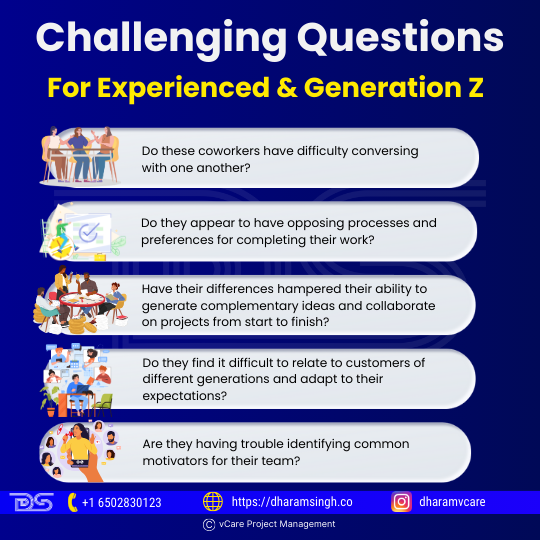
Challenging Questions For Experienced & Generation Z
But it might be better if the experienced employee tries to learn about Gen Z’s as they are thoroughly updated on technologies and adapted to hybrid working culture. Some aspects that may build the bond between experienced and Gen Z employees:
- Gather inputs from each other
- Live the culture
- Create opportunities for face-to-face interaction
- Facilitate frequent peer-to-peer recognition
- Form cross-generational teams
- Implement social technology for building relationships at work
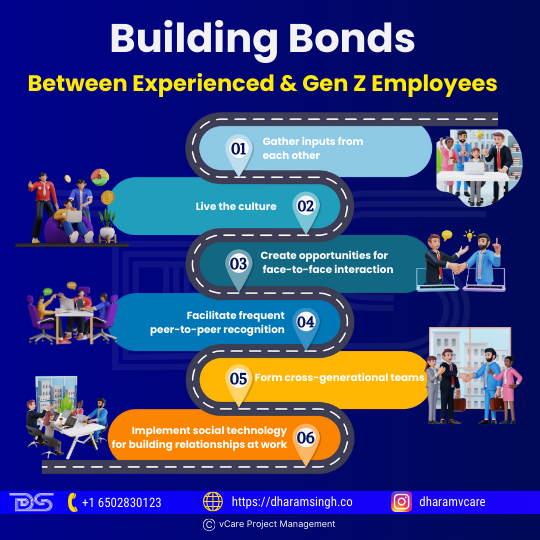
Building Bonds Between Experienced & Gen Z Employees
The Skills Challenges of the Future Workforce
Technology, globalization, demographics, social values, and changing personal expectations of workforce participants are causing a dramatic change in the future of work and the workforce. As per The Future of the Workforce study, there are four significant workforce causes of disruption:
- Demographic upheaval
- Ever-present and changing digital technology
- An accelerated rate of change and business-model innovation
- The rise of a new social contract
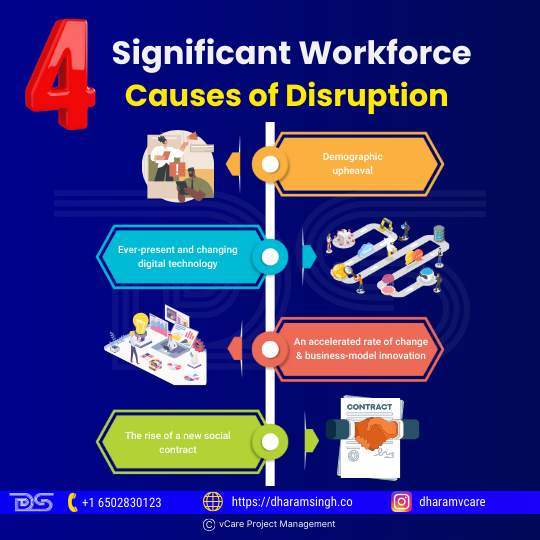
Significant Workforce Causes of Disruption
To survive the hypercompetitive, fast-paced future of work, an organization must be laced with strong interpersonal connections across a diverse workforce. In the aspect of a better workforce in the future, the employees need to necessitate the combination of four key work skills:
- Digital tools and technological abilities
- Good understanding of analytics and data
- Business management abilities
- Design and creative abilities
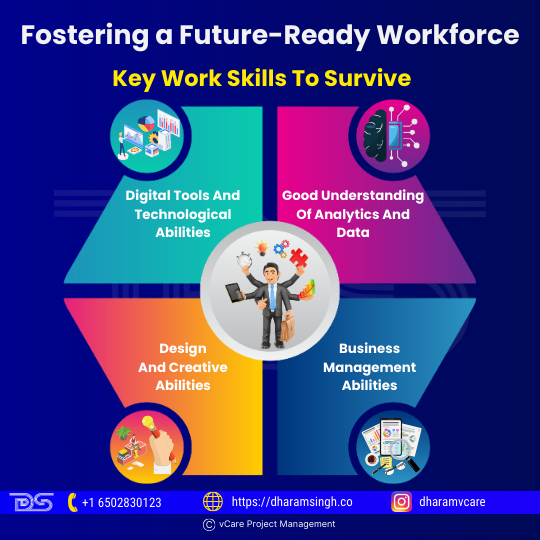
Key Work Skills to Survive
Get adapted to change
The projectification of work has rapidly shifted the nature of most professionals’ work, moving away from routine operations and decisively toward project leadership. In this new world, executives must answer three critical questions.
- Is your organization prepared to thrive in the project-based economy?
- Do professionals in your organization have the necessary adaptive mindset to carry out critical projects?
- Do your project managers have the business skills to prioritize competing workstreams and align with shifting business priorities?
The way forward
Great projects don’t just improve work; they improve the world. Key characteristics that leaders must possess to excel in a project-driven world:
- Project management skills
- Product development and subject matter expertise
- Strategy and business acumen
- Leadership and change management skills
- Agility and adaptability
- Ethics and values
Managers and organizations must become comfortable devising strategies driven by change rather than efficiency to transform themselves and thrive in the new project economy. They must delegate more resources, budgets, and decision-making authority to projects and project teams rather than the traditional departmental hierarchy. They will need to develop project management skills and adopt new technologies. Finally, they must encourage a shift in emphasis away from inputs and outputs and toward outcomes and value.

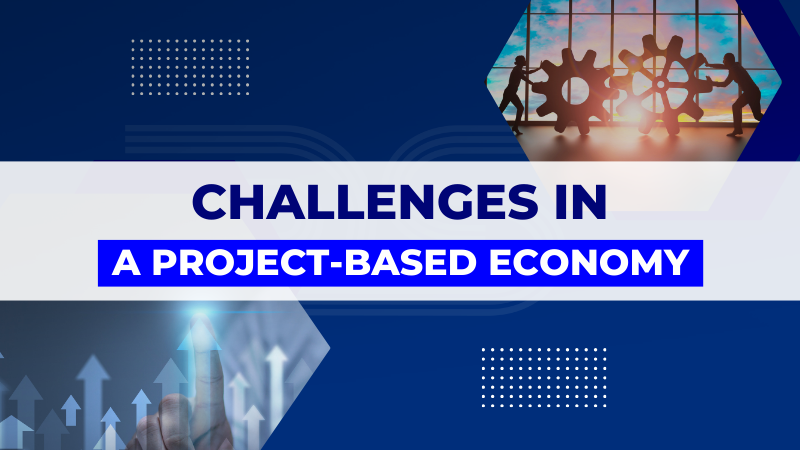
Recent Comments